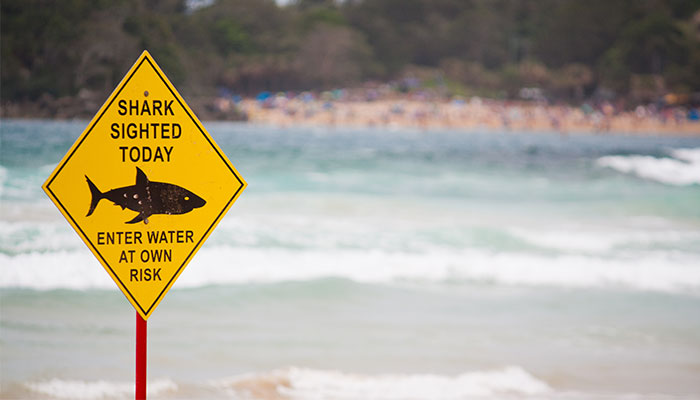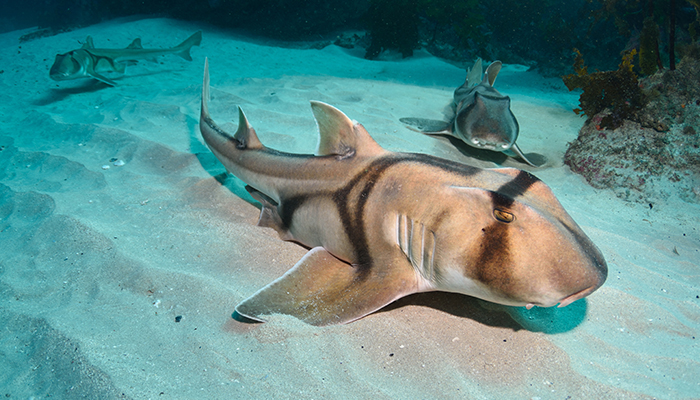World-first findings about where and when sharks are more likely to bite people are throwing light on why areas such as the Far North Coast of NSW are hot spots for shark attacks.
Enter at your own risk: The study has pinpointed the areas where great white, tiger and bull sharks are most likely to attack. Videographer: Sophie Gidley.
Led by Macquarie University, the research has discovered that the risk of great white shark attack increases near river mouths, at times of high rainfall and, despite an overall trend for more attacks when the sea is warmer which coincides with more people using the ocean for recreation, also in water that is cooler than usual.
Attacks by bull sharks are more likely within one kilometre of a river mouth and in summer, and by tiger sharks when rainfall has been high. Together, the three species have been responsible for every fatal shark attack on record in Australia, and for three-quarters of attacks in total.
Shark bites are still rare events but they have been increasing substantially over the past 20 years and often occur in clusters.
Analysing 101 years’ worth of data from the Taronga Zoo-curated Australian Shark Attack File (ASAF), the Modelling Shark Attacks, Australia study aimed to understand how environmental conditions relate to the risk of shark bites in order to build models that can predict when the likelihood of shark attack is highest.
“Shark bites are still rare events but they have been increasing substantially over the past 20 years and often occur in clusters,” says study co-author Nathan Hart, Associate Professor of Comparative Neurophysiology in the Department of Biological Sciences at Macquarie.
Lethal three responsible for 630 bites
He said the findings showed that oceanographic and climatic forecasts could be used to predict where and when sharks are more likely to bite. This could potentially translate into warning systems, such as signs on beaches, that alert water users at times of increased risk, as well as into the management of shark mitigation systems, such as nets and drum lines, in a way that reduces their cost and the environmental damage they cause.

Knowledge is power: Researchers hope their findings will result in increased patrols, flyovers and signs on beaches to protect swimmers at times of increased risk.
Using the predictive models could also result in more efficient deployment of safety measures such as increased patrols or flyovers of beaches in question, “so we don't want people to stay out of the water and we’re not trying to freak them out,” Hart says. “Rather, we’re hoping to increase education about risk and better target resources that might be deployed in that area to try and keep people safe.”
- Drownings up: Foreign visitors can’t spot the risks at beaches and rivers, study finds
- Wetsuits that hide humans from sharks
The researchers’ analysis of the ASAF data showed that over the 101-year period from 1915 to 2015, there were 835 people bitten by sharks in Australian waters, attributed to 12 different shark species. One in every four of these attacks was fatal, and three species of shark were responsible for all of those fatal attacks: white sharks, tiger sharks, and bull/whaler sharks.
Of the 835 bites, 630 (75 per cent) were attributed to the same three species, and after curation of the ASAF data 531 of these were further analysed by the researchers, with 237 bites inflicted by white sharks, 160 by tiger sharks and 134 by bull/whaler sharks.
Cool water finding in great-white hot spot
To better understand attacks by great white sharks, the researchers homed in on the Far North Coast of NSW around Byron Bay and Ballina, where 16 per cent – or nearly one in 5 – of attacks in Australian waters have occurred, including a spate of 11 between 2014 and 2016, two of them fatal. The most recent bite was in February this year, when a 41-year-old surfer at Belongil Beach suffered severe lacerations to his upper leg.
Using historical data on sea surface temperatures, the researchers were able to establish that attacks were occurring in areas along the coast where the water was cooler, either compared with surrounding areas of water, or compared to the same site the year before or the year after the time of the attacks.

World-first findings: Associate Professor Nathan Hart and Dr Laura Ryan analysed 101 years of data from every known Australian shark attack using records kept at Taronga Zoo.
“These pockets of cooler water are caused by upwelling events, where dense, cool, and nutrient-rich water gets forced up against the coast. Such areas of the ocean are highly productive and sharks may be attracted by the abundance of fish or other prey, such as seals, that might follow the fish,” Hart explains.
The researchers established that white shark attack risk peaked when monthly rainfall was 100mm, and that tiger shark risk also increased significantly with rainfall.
“What causes these cool upwellings, specifically on the Far North Coast of NSW where there has been a higher than normal rate of bites and attacks, is the strengthening of the warm East Australian Current, so what’s nice about that is potentially we can look at the climatic factors which affect ocean current movement, and so have a little bit of a warning ahead of time.”
The study, assisted by researchers from the Taronga Conservation Society, the NSW Department of Primary Industries and the University of NSW, found other hot spots for white shark attacks along the south-west coast of Western Australia. Bull shark attacks were most common at higher latitudes along the north of Western Australia and east coast of Queensland, while attacks by tiger sharks had the highest occurrence in the northern parts of Australia, close to tropical reef locations, as well as around Sydney.
Tiger and bull sharks are both found in the Whitsundays, site of Australia’s most recent attack in which an English tourist had his foot bitten off and his friend’s calf was mauled.
Rainfall’s role in higher attack rise
“One of the key findings is that you can't just lump all sharks together; you get a much better result if you use different models for the different species of shark and this reflects differences in their ecology,” says Hart.
Proximity to river mouths is implicated for all three species, says Hart, because they are productive areas for shark prey. Rainfall makes them even more so. Using rainfall data from the Bureau of Meteorology, the researchers established that white shark attack risk peaked when monthly rainfall was 100mm, and that tiger shark risk also increased significantly with rainfall.
- Stellar idea: Sydney's first national park in the sky
- How surgeons are tranforming lives through low-cost operations
“In a similar way to what we see with changes in ocean currents, if you have substantial rainfall it washes out nutrients and they are then concentrated where the river meets the sea, so you’re likely to see higher productivity which leads to higher fish populations, so sharks are going to be attracted to that,” Hart says.
“Especially with high rainfall, you might also get a very turbid environment close to the river mouth because the water washes down a lot of silt. This might increase the likelihood of getting bitten by a shark because they can’t see you as clearly and they’re having to rely on their other senses to decide what you are, and so they may end up mistaking you for their normal prey or just biting you out of curiosity.
“It’s a bit like us trying to find our way around a room in the dark; you can do it with your other senses such as touch, but it's much harder compared to when you are able to use your eyes and the chances of you bumping into something are a lot higher.”
- Dr Nathan Hart is Associate Professor of Biological Sciences (Comparative Neuro-Physiology) in the Department of Biological Sciences.



